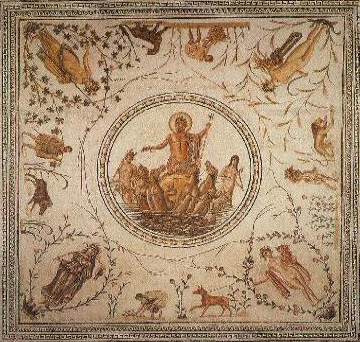Physical
Aspects of the Polytheistic Roman Style
Physically,
mosaic imagery of gods from this time period was constructed predominantly
on the floor. Giving the images a very earthy tone and connection,
the ceilings and walls tended to be avoided in the production
of a mosaic during the earlier years of the ancient Roman Empire.
There also tended to be great definition in the images, for mosaic
art naturally creates an impression of well-defined borders and
edges. The stones and tiles used in the art form naturally curve
and don’t usually connect, creating boundaries as well as
definition and an impression of refinement. The use of many tiles
gives the image a feeling of detail, texture, and almost rough
personality, without many flat or smooth areas apparent in the
least. The following is a particularly strong example of the style
supporting this observation

.
Though symmetry is quite possible in the mosaic medium, Roman
depictions of gods tend not to incorporate it, for although characteristics
can be refined and detailed, they do not require a significant
amount of symmetry to convey the sought-after impression. What
is unique about these images is the inability to blend images
to a great extent. As a result of the mosaic’s blocky and
definitive nature, figures and images generally become separated
from one another, and each character becomes more prominent only
with the use of size or color.
A significant characteristic of ancient Roman mosaic art depicting
multiple gods is the portrayal of aggressive, dominant, powerful
figures. In order to convey this impression, artists enlarge the
focus of the image and center it.

.
This image very well illustrates this point, with a depiction
of Neptune standing dominantly and centered between two smaller
figures and is even enlarged relative to the horses pulling the
chariot.
The choice of color in these earlier-style mosaics is very interesting
and offers some insight into the Romans’ ideas and thoughts
about power. In these mosaics, duller, earthy colors are predominant.
The significant use of tans, browns, grays, earthy greens and
yellows conveys a more solemn, respectful feeling, and connects
the gods with the earth, rather than the heavens, which are commonly
portrayed as rich, gold-embossed environments. Rather, the gods
seem to be presented in the real world. There is no fancy gold
lining, jewels, or other items conveying feelings of richness;
instead, these portrayals of gods are placed in more commonplace,
simpler contexts.
This
may offer insight into the Romans’ ideas concerning richness,
or rather the unimportance of the symbol of richness in the eyes
of the Romans. This you will see in the next section, devoted
to a more symbolic analysis of the style.
Though sometimes present, smaller adoring, praising figures are
generally not portrayed; the focus of the mosaic tends to be a
large, centered figure portrayed as physically strong, and frequently
appearing as the commander of some other image. Also, importantly,
the figures tend to be portrayed in an actual worldly context,
such as the sea. In the following image, Neptune is portrayed
as a very dominant figure, enlarged relative to the rest of the
image, surrounded by smaller creatures, and commandeering his
chariot in the context of the ocean (as evidenced by the marine
creatures surrounding him).

.
In order to convey the feeling of power, the focal figure stands
tall with his head raised and confidently rules over the other
figures. The god is given a sense of control with the air of confidence
attracting both the viewer’s attention as well as the other
characters’ attention.












